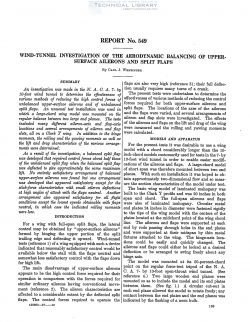naca-report-549

- Version
- 189 Downloads
- 1.56 MB File Size
- 1 File Count
- August 30, 2016 Create Date
- August 30, 2016 Last Updated
National Advisory Committee for Aeronautics, Report - Wind Tunnel Investigation of the Aerodynamic Balancing of Upper Surface Ailerons and Split Flaps

An investigation was made in the N. A. C'. A. 7- by
10-foot wind tunnel to determine the efiectiveness of
various methods of reducing the high control forces of
unbalanced upper-surface ailerons and of unbalanced
split flaps. An unusual test installation was used in
which a large-chord wing model was mounted on the
regular balance between two large end planes. The tests
included many difierent aileron-axis and flap-axis
locations and several arrangements of aileron and flap
slots, all on a Clark Y wing. In addition to the hinge
moments, the rolling and the yawing moments as well as
the lift and drag characteristics of the various arrange-
ments were determined.
As a result of the investigation, a balanced split flap
was developed that required control forces about half those
of the unbalanced split flap when the balanced split flap
was deflected to give approximately the same maximum
lift. No entirely satisfactory arrangement of balanced
upper-surface ailerons was found but one arrangement
was developed that appeared satisfactory except for the
stick-force characteristics with small aileron deflections
at high angles of attach: with the flaps neutral. Another
arrangement also appeared satisfactory for; all flight
conditions except the lowest speeds obtainable with flaps
neutral, in which case the indicated rolling moments
were low.
For a wing with full-span split flaps, the lateral
control may be obtained by “upper-surface ailerons”
formed by hinging the upper portion of the split
trailing edge and deflecting it upward. Wmd—tunnel
tests (reference 1) of a wing equipped with such a device
indicated that reasonably satisfactory control would be
available below the stall with the flaps neutral and
somewhat less satisfactory control with the flaps down
for high lift.
The main disadvantage of upper-surface ailerons
appears to be the high control force required for their
operation in comparison with the forces required for
similar ordinary ailerons having conventional move-
ment (reference 2). The aileron characteristics are
affected to a considerable extent by the deflected split
flaps.
| File | Action |
|---|---|
| naca-report-549 Wind Tunnel Investigation of the Aerodynamic Balancing of Upper Surface Ailerons and Split Flaps.pdf | Download |

Comment On This Post